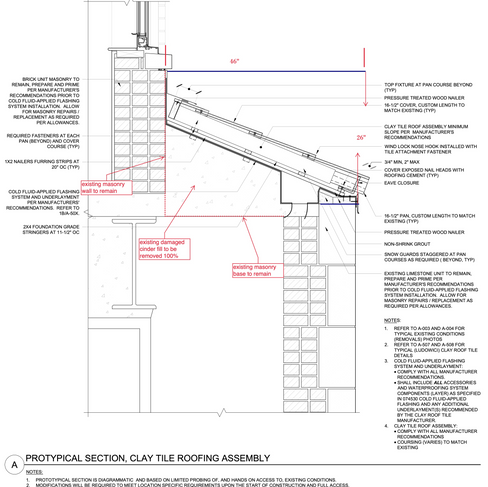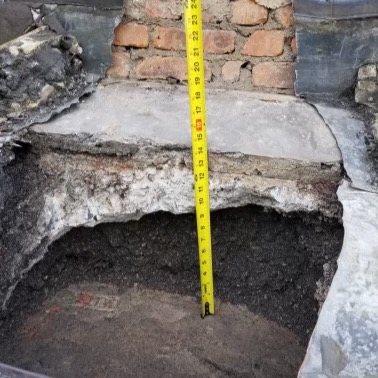Restoring the Historic Roof at 110 E 42nd Street, New York
- Eva Hatzaki, Editor
- Oct 25, 2023
- 4 min read
Updated: Oct 27, 2023
Preserving New York's Heritage One Tile at a Time
- By Amy DeLuca
Senior Project Manager/ Studio Lead, CANY
The first time that I stepped foot onto a scaffold, brand new to the restoration world, I climbed across an 18-story pipe scaffold spread across the expansive sandstone façade of 110 E 42nd Street as it rose over 42nd Street.

Work ongoing via suspended scaffolds at the north and east elevations at 110 E 42nd Street. (PHOTOS: CANY)
That project in 2010 was a full restoration, including masonry repairs, cleaning, re-painting, and steam cleaning of the facades. Skyline Restoration worked with CANY on the exterior repairs, while CetraRuddy Architects and Higgins & Quasbarth were additional consultants. Working closely with the Landmarks Preservation Commission, the building was respectfully polished up and given new life.
As anyone in the restoration world can tell you, however, that new life requires constant upkeep. Buildings are in a constant battle with the often-harsh winter conditions of New York City. As a part of the city’s Façade Inspection and Safety Program, CANY has continued to inspect and oversee the repairs on 110 E 42nd Street over the years. In 2019 it became apparent that the clay tile roof would need a more serious intervention, and the focus of the current repair campaign began to form.

CANY selected the Ludowici “Cubana” tile based on the dimensions and specific curvature of the tile. The challenge of evenly mixing in six colors fell to Skyline Restoration. (PHOTOS: CANY)
The historic clay tile roof has not been fully replaced since its installation in the 1920s. Spot repairs over the years have replaced broken tiles or attempted to cover leakage areas with surface applied waterproofing. CANY performed several probes to understand the full assembly from tile down to structural deck. The tiles were mortared and wired together and set on a wire-lath-reinforced bed of mortar. Below the mortar bed, copper sheeting extended continuously from the parapet or rising walls to the roof edges. The copper acted as the waterproofing membrane over a concrete substrate. Over the years, the mortar between the tiles had cracked and disengaged. Any damages to the copper below allowed water to enter the building.
As the repair campaign started, CANY and Skyline encountered several challenges, including color selection, demolition surprises, and shop drawing finalization.
The color variation on the final tile installation mimics the historic
CANY selected the Ludowici “Cubana” tile based on the dimensions and specific curvature of the tile. The challenge of evenly mixing in six colors fell to Skyline Restoration.
Ludowici Tile supplied several tile samples for color and shape consideration. With many spot replacements over the years, various colors and tile shapes were present in the assembly. Previous replacements had utilized a more common modern tile shape that did not match the historic 1920s tile.
Top: Existing tile removed for measurements. Middle: Ludowici tile color variations. Bottom: Ludowici tile profile variations. (PHOTOS: CANY)
CANY selected the Ludowici “Cubana” tile based on the dimensions and specific curvature of the tile as it most closely matched the original.
The existing installation contained variegated shades from dark to light. Modern fabrication allowed for three ranges within one color: light, medium, and dark.
CANY chose two colors, resulting in a combination of six shades total. LPC reviewed and approved this approach. As part of the ongoing project, the challenge of evenly mixing in these six colors has fallen to Skyline. From the first mock-up, the installation has artfully mixed the tile shades. The color variation on the final installation mimics the historic closely and has been very successful.
Probes at the 18th Floor deck showed unreinforced concrete topping slabs over loose cinder fill that had previously provided slope. Due to its complete instability, this whole portion had to be removed. (DRAWINGS/PHOTOS: CANY)
Several rounds of shop drawings worked out the wood structures required to provide adequate slope and anchorage. (DRAWINGS/PHOTOS: CANY)
Demolition surprises
During demolition of the existing roofing assembly, CANY and Skyline encountered a few demolition surprises. At the 18th Floor Setback Roof, what was considered the underlying concrete deck was found to be cracked and broken typically across the entire length. In cutting deeper, loose cinder fill poured from the probes. Instead of being able to anchor to this deck as was possible at the upper roof sections, the entire assembly had to be removed. Demolition here took far longer than anticipated with such an excess of material to remove- up to a foot of loose cinder fill in places. With the absence of any reinforcing, this area appeared to be only for creating slope at the larger tile roof area.
Shop drawing creation and review became a process as the design for a new structure to create slope at this level had to be re-introduced. A lighter weight wood structure was chosen for ease of installation as well as improved access for waterproofing and tile attachment detailing. Pull testing at the substrate below the original concrete confirmed that the new structure could be safely installed.
Despite the challenges inherent in replacing such an involved historic component of the building, the result allows for modern waterproofing and structural attachments while maintaining the look of the original tile installation. Here’s to hoping for another 100 years!🀰

* Amy DeLuca is a Senior Project Manager and Studio Lead at CANY Architecture and Engineering. She studied architecture in Washington D.C. at The Catholic University of America and graduated with both a Bachelor of Science in Architecture and a Master of Architecture. With an interest in historic preservation, she moved to New York and began working in the building envelope field with CANY in 2010. Since then, Amy has had the opportunity to work on a wide variety of historic structures. Decorative terra cotta buildings are her favorite restoration challenge. She is certified for scaffold inspections and is a Level 2 Rope Access Technician with SPRAT.🀰


















Comments